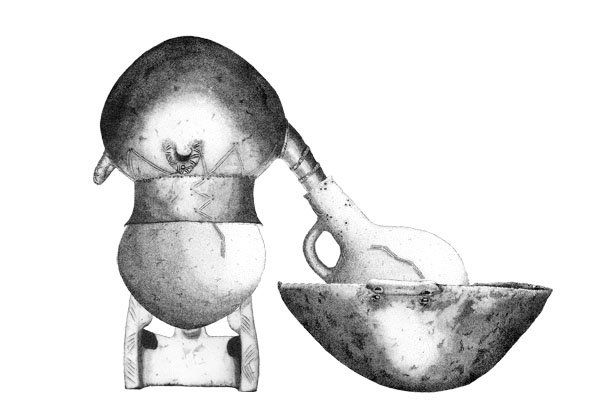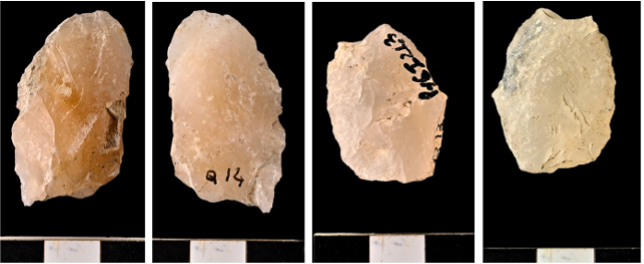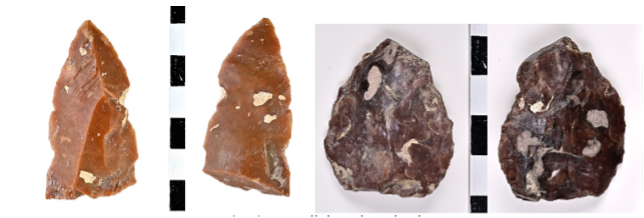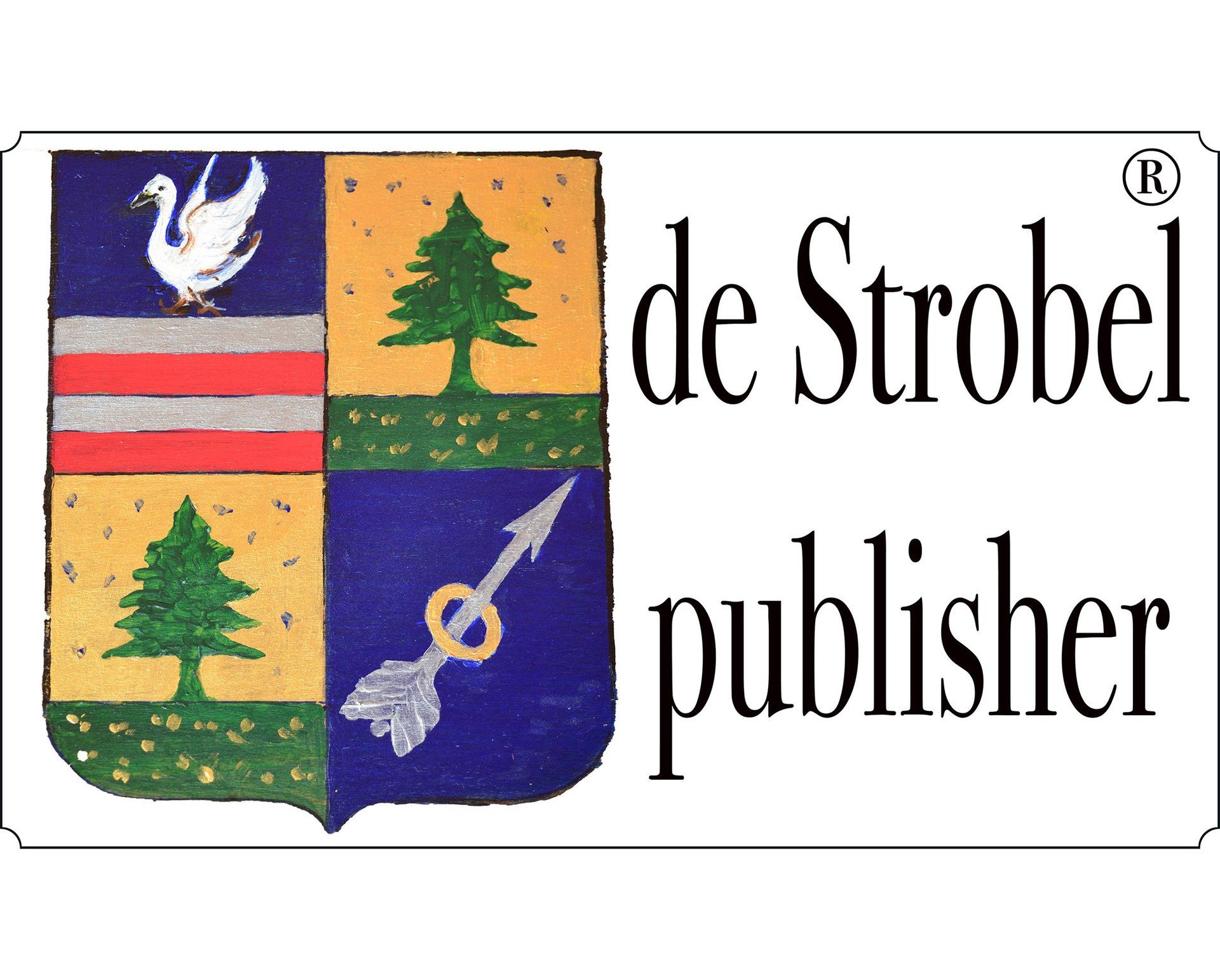

Waiting the imminent publication of Scripta Cypria IV:
“ PYRGOS/MAVRORAKI: THE ACHEULO-YABRUDIAN AND MIDDLEPALAEOLITHIC FREQUENTATION OF THE PALIMPSEST SITE”
by Maria Rosaria Belgiorno and Antonella Minelli,
a report of the preliminary results of the research, has been presented at Leicester on November 7th 2025
during the conference of the Lithic Studies Society.
Report of the research activities for the project sponsored by the MAECI as part of the Archaeological and Ethnoanthropological Missions Abroad 2023 - Cyprus.
Project title: Pyrgos Mavroraki: from the Pre-Neolithic to the Bronze Age
2023 Team
Antonella Minelli, University of Molise, director of the mission
Maria Rosaria Belgiorno, ISPC – CNR, scientific director of the Pyrgos Mavroraki site
Introduction
The mission was proposed by the University of Molise, in collaboration with the Institute of Cultural Heritage Sciences of the CNR in Rome, with which the University activated a research agreement in December 2022, for the study of material culture lithics from the Pyrgos Mavroraki site, located on the southern coast in the Limassol district, Cyprus.
For 2023, the mission enjoyed the patronage of the MAECI and the support of the Italian Embassy in Nicosia, as well as the authorizations for the study of archaeological material, issued by the Department of Antiquities of Cyprus, the body responsible for the protection and safeguarding of cultural heritage of the Cypriot territory.
The research activities took place in September-October 2023 and saw the participation, in addition to the scientific manager of the mission, also of Dr. Maria Rosaria Belgiorno, scientific director since 1998 of the excavation and archaeological research of the Pyrgos/Mavroraki site, former first researcher at the CNR and now senior researcher associated with the ISPC-CNR. The innovative aspect of this research was translated into the detailed analysis of the lithic production of the Pyrgos site, chronologically classifiable from the pre-Neolithic to the Bronze Age, which includes more than 10,000 finds, never the subject of technological-typological study and whose data were fundamental for re-proposing the age-old question of the demographic dynamics of island areas and reviewing the interpretations, perhaps obsolete today, on the arrival/presence of pre-Neolithic human groups on the island of Cyprus.
The archaeological context and the state of the art
The island of Cyprus is characterized, within the Mediterranean basin, among those territories which until today had documented a scant, if any, presence of archaeological evidence preceding the Neolithic period. In reality, although few indications on Paleolithic evidence appear in the literature (Vita-Finzi, 1973), new field research would seem to increasingly point towards a confirmation of Paleolithic evidence, which would have affected a fairly large area, in which the islands (Crete and Naxos, Greece) would have acted as an attractor/isolating context for human groups of the Middle Paleolithic, i.e. the Neanderthals (160,000-130,000 years ago) and then for the modern men themselves of the Upper Paleolithic/Epipaleolithic (Lawler, 2018; Carter et alii, 2019 ). These islands would be part of a process of movement of Paleolithic groups which, through northern Anatolia (with the route of the Sea of Marmara, in the Aegean basin), and western Anatolia, from Turkey (Su¨rmecik site) (H. Tas¸ kıran et alii, 2021) would have been occupied for medium-long periods and would have probably triggered isolation phenomena in which climate changes and rising levels of sea water would have affected not only the conservation of archaeological evidence, but also the reconstruction effectiveness of such movements. Often the kilometric distances between the hinterland and the islands have discouraged archaeologists from hypothesizing such ancient presences on them, but recent research is increasingly refuting such beliefs.
The island of Cyprus fits perfectly into this phenomenon and favourable elements are the findings of chipped pebbles, of the chopper and shredder type, in the north-western area of the island (sites of Orga-Kourvelia and Vasilia-Mosphilia), dated between Lower and Middle Paleolithic (Yurtdas & Özerenler, 2021), as well as a biface, interpreted as Paleolithic by Kholetria-Ortos (Strasser et alii, 2016). The findings from the Aspros site, Dive Site C excavated by A.J. Ammermann appear to date back to the Upper Paleolithic-Mesolithic/Epipaleolithic. (2020). More certain, however, are the materials attributable to the Aceramic Neolithic, which would certainly document a continuous anthropic presence on the island, starting from that date and throughout the Metal Age (see sites of Kalavasos and Choirokoitia).
The Pyrgos Mavroraki site fits into this context and, although to date it has documented an excavated area, with multiple functions and innovations, which tells the story of the life of human groups from the Neolithic period to the end of the Middle Bronze Age II, the review of the finds , in this case lithics, has made it possible to acquire new and important data which would include the site itself in the framework of those fundamental emergencies to rewrite the prehistory of the island and to presumably date the territorial occupation back to the Middle Palaeolithic.
Mission objectives
The objectives that we set out to achieve with the archaeological mission to the Pyrgos Mavroraki site are listed below:
- Reconstruct the cultural substrate that characterized the context of Pyrgos Mavroraki, through the techno-typological and archaeometric study of the chipped lithic industries.
- Apply a study methodology aimed at the timely cataloging of the entire collection of lithic finds, both in chipped and polished stone, through a comparison with known industries of the Mediterranean area, with consequent chrono-typological classification, in reference to the excavation context.
- Definition of the state of conservation of the finds with consequent selection of those with alterations (patinas of various colors and thicknesses) attributable to post-depositional mechanisms of different nature.
- Sampling of raw materials for specific archaeometric analyses, useful for reconstructing the supply areas internal or external to the island, with a reconsideration of the docking points present in the Pyrgos site, overlooking the sea, which would have facilitated the arrival of populations and the exploitation of coastal areas (the Pyrgos site being 4 km from the coast).
- Sampling of finds for traceological analyzes useful for identifying traces connected with the methods of use of the finds.
- Contribute to the valorization of the information acquired through forms of dissemination and digital diffusion that involve local authorities and are aimed at an audience of specialists and non-specialists, according to different levels of publicity.
Interventions carried out: study methodologies, preliminary results, and valorization prospects.
The activities carried out during the mission attempted to consider the objectives set and as such led to the setting up of a work program to be followed for the entire duration of the research, as well as for future missions.
Study methodologies.
First, it was necessary to examine part of the lithic tools available, the result of the excavation campaigns conducted on the Pyrgos Mavroraki site from 1998 to 2012, and then proceed with an initial selection of the finds based on the raw material used and the type and technology identified. The data acquired in this first phase of the research are still considered completely preliminary, but the sample selected in 2023, which amounts to around 500 items, allowed us to carry out an initial screening which led to the distinction of:
- 225 finds in white, hyaline quartz, with pink and gray variants.
- 123 grey-beige colored quartzite finds.
- 16 finds in black obsidian, with a red variant, whose lithology has no comparison on the island, except from external indications, which suggest Armenian-Caucasian origins.
- the remaining pieces can be classified in the lithologies of flint and silicified limestone.
- a quantity of siliceous finds was also selected which show clear evidence of alteration in the form of patinas of different colors.
An alphanumeric database has been prepared in Access for entering the metric and photographic data of each find studied; we proceeded with the paper and digital graphic reproduction of some materials considered most representative, to then facilitate their insertion into spatial interrogation software, with the integration of planimetric and stratigraphic data. The database was also implemented with the inclusion of bibliographic references for comparison for the materials under study.
Preliminary results.
The more purely techno-typological study has allowed us to recognize with a certain certainty a technological component that is predominantly ascribed to the Levallois débitage, which is configured as the technique of processing materials typical of the Middle Paleolithic, with splinters (Figs. 1, 2) and Levallois cores, as well as tips (Fig. 4), and scrapers. The peculiarity highlighted is that this production particularly affects quartz and quartzite finds, whereas in central-western Europe we find it represented in flint materials and to a lesser extent in quartzite and associated with H.nearderthalensis. The laminar products, typical of laminar débitage, are in smaller quantities, mostly obtained from the flint lithotype and can be attributed to the Upper Paleolithic/Epipaleolithic phase.
The production of obsidian finds, however, sees the prevalence of splinters and blades, typical of the phase from the Neolithic onwards, with the sole exception of a scraper/burin (Fig.3) which, typologically, is always part of the technological productions of the Middle Paleolithic.
The flint finds, always attributable to Middle Paleolithic technology, have recorded widespread patinas of post-depositional alteration that entirely cover the artefacts, often making the siliceous texture illegible. These patinas have different colors and thicknesses, which are indicators of different alteration processes, which would have affected their conservation and would reveal a certain antiquity; only future archaeometric analyzes will be able to define the mechanisms and times of their formation.
The presence of red obsidian has also stimulated research into possible comparisons of similar finds inside and outside the island. To date, no similar examples are known in Cyprus, apart from those obtained from black obsidian, so the exceptional nature of the raw material, which is not limited to a single artefact, has suggested provenances that take us back to an area of border, the Armenian-Caucasian one, considered a cornerstone both for the dispersion of Paleolithic and subsequent Neolithic human groups.
What is certain is that the incidence of the Levallois débitage and its association with H.neanderthalensis, as prefigured by the few testimonies known to date for the island of Cyprus (Orga-Kourvelia), has re-proposed the interpretative problem of the population/presence of human groups in the territory well before the Neolithic diffusion, with an increasingly convincing anticipation to the Middle Paleolithic, the evidence of which is well known in the Middle-Eastern Asian area.
Only the in-depth study of all the lithic material, in addition to the preparation of specific archaeometric analyses, also aimed at understanding the methods of formation of the patinas on the siliceous finds, will facilitate the reconstruction of a picture which to this day proves to be quite exceptional and articulated.
The Pyrgos Mavroraki site, with its stratigraphic and planimetric data, could therefore prove to be a key site for shedding new light on the dynamics of the ancient Cypriot population.
Enhancement prospects.
If on a scientific level, with this mission, the foundations have been laid to rekindle the debate on the ancient migratory processes of human groups in the Mediterranean islands, the collaboration with territorial bodies, such as the Department of Antiquities of Cyprus, is equally fundamental to set up a program for the dissemination of new knowledge which will necessarily involve the use of innovative technologies of digital, three-dimensional reconstruction and augmented reality which will make it possible to promote the publicization of information, at different levels of users, through scientific publications and the preparation of a dedicated web page to the Virtual Reality Experience, within the website already set up (https://www.pyrgos-mavroraki.eu/). This channel will contain virtual reproductions connected to the archaeological history of the Pyrgos Mavroraki site and the finds that are the subject of this research which will constitute a model of virtual experience with a strong scientific and social impact.
References
Ammerman, A.J., 2020, Cyprus: The Submerged Final Palaeolithic of Aspros Dive Site C. In: Bailey G., Galanidou N., Peeters H., Jöns H., Mennenga M. (eds) The Archaeology of Europe’s Drowned Landscapes. Coastal Research Library, vol 35. Springer.
Carter T., D. A. Contreras, J. Holcomb, D. D. Mihailović, P. Karkanas, G. Guérin, N. Taffin, D. Athanasoulis, C. Lahaye, 2019, Earliest occupation of the Central Aegean (Naxos), Greece: Implications for hominin and Homo sapiens’ behavior and dispersals, Science Advances, 5, 997, pp. 1-9.
Lawler A., 2018, “Searching for a Stone Age Odysseus Modern humans and even Neandertals may have plied the Mediterranean long ago”. Science, Vol. 360, No. 6387, pp. 362-363.
Strasser T. F., C. Runnels, C. Vita-Finzi, 2016, A possible Palaeolithic hand axe from Cyprus”. Antiquity Project Gallery, 90 (350).
Tas¸ kıran H., Y. Aydın, Kadriye O¨ zc¸elik, Es¸ ref Erbil, 2021, A new discovery of Neanderthal settlements in Turkey: Su¨ rmecik open-air campsite in Western Anatolia. L’Anthropologie 125, 102838.
Vita-Finzi C., 1973, Palaeolithic finds from Cyprus? Proceedings of the Prehistoric Society, 39, pp. 453-454.
Yurtdas E., M. Özerenler, 2021, Morphou Bay Prehistoric Survey preliminary report: Pebble tools From Orga-Kourvelia and Vasilia-Mosphilia. TÜBA-AR 29/2021, pp. 177-195.
Campobasso, 23/02/2024
Prof.ssa Antonella Minelli Maria Rosara Belgiorno
Waiting the imminent publication of Scripta Cypria IV:
“ PYRGOS/MAVRORAKI: THE ACHEULO-YABRUDIAN AND MIDDLEPALAEOLITHIC FREQUENTATION OF THE PALIMPSEST SITE”
by Maria Rosaria Belgiorno and Antonella Minelli,
a report of the preliminary results of the research, has been presented at Leicester on November 7th 2025
during the conference of the Lithic Studies Society.





